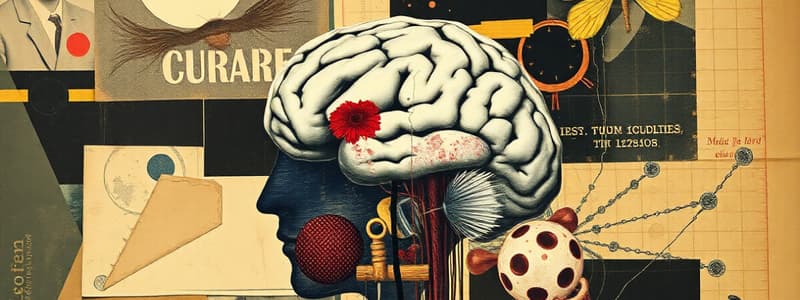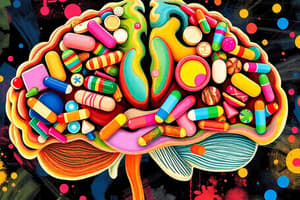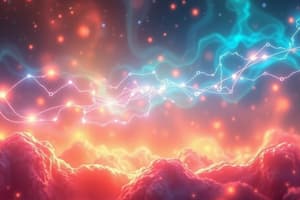Podcast
Questions and Answers
What is the primary mechanism of action of d-tubocurarine?
What is the primary mechanism of action of d-tubocurarine?
- It inhibits the reuptake of dopamine.
- It acts as an agonist at nicotinic receptors.
- It antagonizes acetylcholine at the receptor sites. (correct)
- It enhances acetylcholine release.
Which of the following is NOT a treatment for curare poisoning?
Which of the following is NOT a treatment for curare poisoning?
- Physostigmine
- D-tubocurarine (correct)
- Atropine
- Neostigmine
Which statement about neostigmine is true based on the context provided?
Which statement about neostigmine is true based on the context provided?
- Neostigmine causes a decrease in muscle strength.
- Neostigmine has no effect on consciousness.
- Neostigmine acts as an acetylcholinesterase inhibitor. (correct)
- Neostigmine is an antagonist at acetylcholine receptors.
What is the main alkaloid responsible for the paralysing actions of the curare vine?
What is the main alkaloid responsible for the paralysing actions of the curare vine?
What significant outcome was observed 36 hours after the administration of neostigmine in the case presented?
What significant outcome was observed 36 hours after the administration of neostigmine in the case presented?
What is the primary focus of neuropharmacology?
What is the primary focus of neuropharmacology?
Which of the following is a central learning outcome of the neuropharmacology unit?
Which of the following is a central learning outcome of the neuropharmacology unit?
Which field is NOT directly related to pharmacology as noted?
Which field is NOT directly related to pharmacology as noted?
Which aspect of neurotransmitter pharmacology is emphasized in this introduction?
Which aspect of neurotransmitter pharmacology is emphasized in this introduction?
What does neurotransmitter pharmacology primarily involve?
What does neurotransmitter pharmacology primarily involve?
Which time period is most relevant to the historical context of pharmacology presented?
Which time period is most relevant to the historical context of pharmacology presented?
Which statement about neurotransmitters is NOT a focus of this neuropharmacology introduction?
Which statement about neurotransmitters is NOT a focus of this neuropharmacology introduction?
What does neuropharmacology study?
What does neuropharmacology study?
Which term specifically relates to the effects of drugs on psychological parameters like emotion and cognition?
Which term specifically relates to the effects of drugs on psychological parameters like emotion and cognition?
In vivo neuropharmacology primarily focuses on what?
In vivo neuropharmacology primarily focuses on what?
What is the main subject of medical neuropharmacology?
What is the main subject of medical neuropharmacology?
Which of the following methods would be used in in vitro neuropharmacology?
Which of the following methods would be used in in vitro neuropharmacology?
Which aspect is NOT typically included in neuropharmacology?
Which aspect is NOT typically included in neuropharmacology?
Neuropsychopharmacology integral study is aimed at understanding drugs' impact on which area?
Neuropsychopharmacology integral study is aimed at understanding drugs' impact on which area?
What does the concentration response relationships in in vitro neuropharmacology examine?
What does the concentration response relationships in in vitro neuropharmacology examine?
Which of the following best describes neurotechniques in relation to neuropharmacology?
Which of the following best describes neurotechniques in relation to neuropharmacology?
What was the patient's Glasgow Coma Scale (GCS) score upon examination?
What was the patient's Glasgow Coma Scale (GCS) score upon examination?
What initial resuscitation measures were performed on the patient?
What initial resuscitation measures were performed on the patient?
Which substance is suggested to have poisoned the patient?
Which substance is suggested to have poisoned the patient?
What key clinical manifestation was noted shortly after the patient was stabilized?
What key clinical manifestation was noted shortly after the patient was stabilized?
Who analyzed the fish remnants associated with the patient?
Who analyzed the fish remnants associated with the patient?
What type of fish was identified as the source of poisoning?
What type of fish was identified as the source of poisoning?
Which of the following is NOT a symptom associated with tetrodotoxin poisoning?
Which of the following is NOT a symptom associated with tetrodotoxin poisoning?
What was the patient's condition prior to being transferred to the intensive care unit (ICU)?
What was the patient's condition prior to being transferred to the intensive care unit (ICU)?
What family member approached the medical staff with information about the fish consumed by the patient?
What family member approached the medical staff with information about the fish consumed by the patient?
What does the presence of absent deep tendon reflexes indicate in this context?
What does the presence of absent deep tendon reflexes indicate in this context?
What is the origin of the name 'Tetrodotoxin'?
What is the origin of the name 'Tetrodotoxin'?
What is the approximate IC50 value for Tetrodotoxin?
What is the approximate IC50 value for Tetrodotoxin?
What clinical treatment was administered to the patient who suffered from severe illness due to neurotoxin exposure?
What clinical treatment was administered to the patient who suffered from severe illness due to neurotoxin exposure?
What was one of the notable improvements seen in the patient after the first dose of neostigmine?
What was one of the notable improvements seen in the patient after the first dose of neostigmine?
Which of the following is NOT a characteristic of Tetrodotoxin?
Which of the following is NOT a characteristic of Tetrodotoxin?
What does the term 'mole' refer to in the context of chemistry?
What does the term 'mole' refer to in the context of chemistry?
What type of medication is neostigmine?
What type of medication is neostigmine?
Which of the following aspects does Tetrodotoxin primarily affect?
Which of the following aspects does Tetrodotoxin primarily affect?
In what year was the Journal of Neurophysiology article that mentioned Tetrodotoxin published?
In what year was the Journal of Neurophysiology article that mentioned Tetrodotoxin published?
Which species is primarily associated with Tetrodotoxin?
Which species is primarily associated with Tetrodotoxin?
Flashcards
What is neuropharmacology?
What is neuropharmacology?
The study of how drugs affect the nervous system.
Axonal conduction
Axonal conduction
The process by which an electrical signal travels down the axon of a neuron.
Neurotransmitters
Neurotransmitters
Chemical messengers that transmit signals between neurons at synapses.
Synaptic transmission
Synaptic transmission
Signup and view all the flashcards
Neurotransmitter pharmacology
Neurotransmitter pharmacology
Signup and view all the flashcards
Agonists
Agonists
Signup and view all the flashcards
Antagonists
Antagonists
Signup and view all the flashcards
Neuropharmacology
Neuropharmacology
Signup and view all the flashcards
Psychopharmacology
Psychopharmacology
Signup and view all the flashcards
Neuropsychopharmacology
Neuropsychopharmacology
Signup and view all the flashcards
Medical Neuropharmacology
Medical Neuropharmacology
Signup and view all the flashcards
In Vitro Neuropharmacology
In Vitro Neuropharmacology
Signup and view all the flashcards
In Vivo Neuropharmacology
In Vivo Neuropharmacology
Signup and view all the flashcards
Neuroanatomy
Neuroanatomy
Signup and view all the flashcards
Neurophysiology
Neurophysiology
Signup and view all the flashcards
Neurotechniques
Neurotechniques
Signup and view all the flashcards
Lagocephalus sceleratus
Lagocephalus sceleratus
Signup and view all the flashcards
Tetrodotoxin (TTX)
Tetrodotoxin (TTX)
Signup and view all the flashcards
Deep coma
Deep coma
Signup and view all the flashcards
GCS score of 3
GCS score of 3
Signup and view all the flashcards
Complete muscle paralysis
Complete muscle paralysis
Signup and view all the flashcards
Absent deep tendon reflexes
Absent deep tendon reflexes
Signup and view all the flashcards
Typical clinical manifestations of TTX poisoning
Typical clinical manifestations of TTX poisoning
Signup and view all the flashcards
Temporal proximity to consumption
Temporal proximity to consumption
Signup and view all the flashcards
Supportive measures
Supportive measures
Signup and view all the flashcards
Intensive care unit (ICU)
Intensive care unit (ICU)
Signup and view all the flashcards
What is d-tubocurarine?
What is d-tubocurarine?
Signup and view all the flashcards
How does d-tubocurarine work?
How does d-tubocurarine work?
Signup and view all the flashcards
Why is the diaphragm muscle less sensitive to d-tubocurarine?
Why is the diaphragm muscle less sensitive to d-tubocurarine?
Signup and view all the flashcards
What is the antidote for curare poisoning?
What is the antidote for curare poisoning?
Signup and view all the flashcards
What is IC50 of d-tubocurarine?
What is IC50 of d-tubocurarine?
Signup and view all the flashcards
What is tetrodotoxin (TTX)?
What is tetrodotoxin (TTX)?
Signup and view all the flashcards
How does TTX affect neurons?
How does TTX affect neurons?
Signup and view all the flashcards
What is the IC50 of TTX?
What is the IC50 of TTX?
Signup and view all the flashcards
What drug is used to treat TTX poisoning?
What drug is used to treat TTX poisoning?
Signup and view all the flashcards
How do cholinesterase inhibitors work?
How do cholinesterase inhibitors work?
Signup and view all the flashcards
How does neostigmine help in TTX poisoning?
How does neostigmine help in TTX poisoning?
Signup and view all the flashcards
What is molar concentration?
What is molar concentration?
Signup and view all the flashcards
What is a mole (mol)?
What is a mole (mol)?
Signup and view all the flashcards
What are voltage-gated sodium channels?
What are voltage-gated sodium channels?
Signup and view all the flashcards
How do voltage-gated sodium channels contribute to nerve impulses?
How do voltage-gated sodium channels contribute to nerve impulses?
Signup and view all the flashcards
Study Notes
Introduction to Fundamental Neuropharmacology
- Serra da Capivara National Park in northeast Brazil is approximately 25,000 years old.
- The park has cave paintings.
Learning Outcomes
- Define neuropharmacology.
- Revisit axonal conduction, neurotransmitters, and synaptic transmission using a neuropharmacological approach (3 case stories).
- Review different types of neurotransmitters and neurotransmitter receptors.
- Define neurotransmitter pharmacology and outline the schedule for the unit.
Pharmacology and Advancement of Science
- Pharmacology's history has progressed from ancient times to the modern era.
- Early forms of pharmacology included magic potions and herbal remedies.
- Later, chemistry and biomedical sciences further developed the field.
- Today, pharmacology incorporates biochemistry, molecular biology and synthetic drugs into treatments.
Pharmacology and its Sub-disciplines
- Pharmacology encompasses various sub-disciplines, including: clinical medicine, veterinary medicine, and others.
- Specific sub-disciplines include: psycho-pharmacology, clinical pharmacology, veterinary pharmacology, and pharmacogenetics.
What is Neuropharmacology?
- Neuropharmacology studies drugs that affect the nervous system.
- This includes effects on sensory perception, motor function, mood, higher cognitive function and other nervous system activities.
Other Related Terms
- Psychopharmacology: focuses on drug effects on psychological parameters like emotion and cognition.
- Neuropsychopharmacology: studies all drug effects on the nervous system.
- Medical neuropharmacology studies the effects of medicines and their side effects.
- In vitro neuropharmacology: studies drug effects on isolated tissues or neurons to understand concentration-response relations.
- In vivo neuropharmacology examines drug effects on organisms and animals helping in determining dose-response relations.
Case Story 1: Let's Go Fishing
- Picrotoxin a poison from fishberry seeds affects GABAA receptors.
- Picrotoxin is also a non-competitive GABAA receptor antagonist.
- Picrotoxin is used to study anesthetic mechanisms and as an antidote for barbiturate toxicity.
Case Story 1: Let's Go Fishing, and Have a Beer!
- Cocculus indicus, a plant from Southeast Asia, contains a poisonous compound.
- It has traditionally been used to kill lice and stun fish.
Case Story 2: Food Poisoning
- A 52-year-old patient presented with nausea, vomiting, dyspnea, perioral paraesthesia, and muscle weakness after consuming the liver and gonads of a pufferfish (Lagocephalus sceleratus).
- Symptoms rapidly progressed to respiratory failure, bradycardia, and cardiac arrest.
- The patient was initially resuscitated, and after stabilisation, displayed complete paralysis and lack of pupillary reflexes.
Case Story 1: Food Poisoning
- The patient's family reported the consumption of Lagocephalus sceleratus (pufferfish).
- Tetrodotoxin (TTX) poisoning was suspected.
Voltage-Gated Channels
- Voltage gated channels are crucial for action potential transmission.
- Sodium (Na+) and Potassium (K+) ions move across the membrane, resulting in changes in membrane potential.
Tetrodotoxin (TTX)
- TTX is a potent neurotoxin found in pufferfish.
- It blocks voltage-gated sodium channels.
- This prevents action potential propagation.
Case Story 3: The Disappearance of Life
- A detailed case presentation for case 3 is not available in the provided text. Only mentions the case title.
Curare Vine
- Curare vine, a liana, contains alkaloids crucial for making arrow and dart poisons.
- The main alkaloid is d-tubocurarine.
- d-Tubocurarine is a receptor antagonist at Acetylcholine receptors, leading to paralysis.
Neurotransmitters and other signaling molecules
- Neurotransmitters are chemical messengers released when nerves are electrically stimulated.
- These are classified into classical and non-classical. Classical neurotransmitters include acetylcholine, amino acids (glutamate, GABA, glycine), monoamines (noradrenaline, adrenaline, serotonin, dopamine).
- Non-classical neurotransmitters include neuromodulators (e.g., neuropeptides, opiates, gaseous transmitters) and neurotrophic factors such as BDNF.
Fundamental Neuropharmacology
- Fundamental neuropharmacology is focused on the effects of chemicals interacting with neurotransmitter receptors.
- It includes measuring, quantifying, and explaining effects.
Neurotransmitters and their function
- A summary table is provided for different neurotransmitters and their associated functions
Study Materials
- Neuropharmacology textbooks, specifically from the authors indicated, are suggested.
Example Question L1
- The main molecular target of picrotoxin is the GABAA receptor.
Weekly Schedule
- A detailed schedule for neuropharmacology classes.
Studying That Suits You
Use AI to generate personalized quizzes and flashcards to suit your learning preferences.




